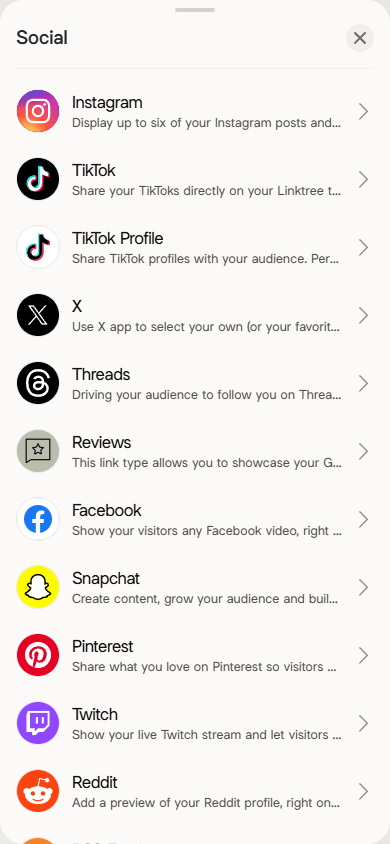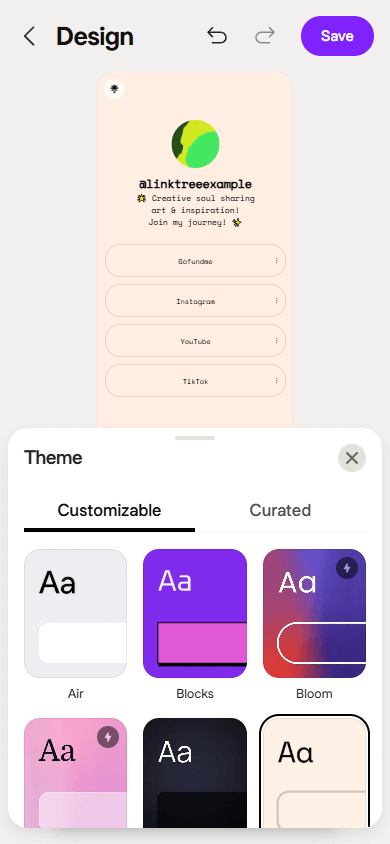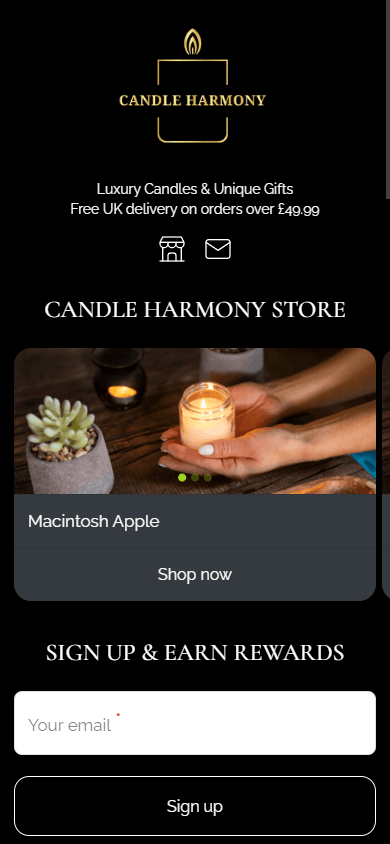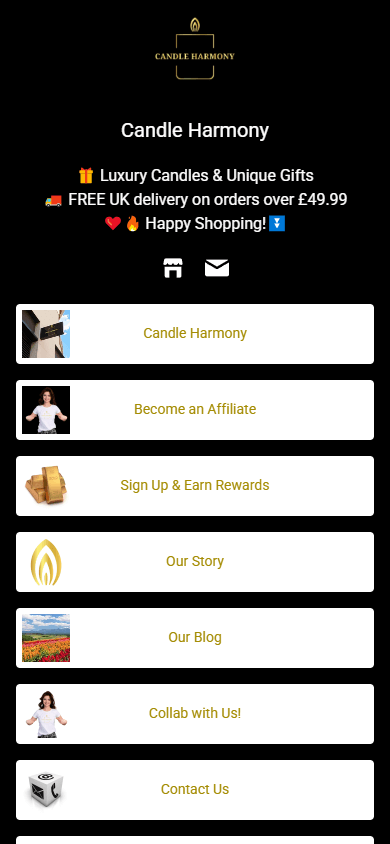Linkpop vs Linktree: Ultimate comparison & real verdict

Since Linkpop isn’t available anymore, Linktree can easily replace it. It offers more features — though many are paid. Here’s a quick comparison between Linkpop and Linktree.
| Linkpop | Linktree | |
| 🔥 Best for… | Shopify sellers | Influencers, content creators |
| 💬 Content | Links, music, videos, Shopify products | Links, music, videos, text, forms, FAQ, digital products |
| 🎨 Customization | Very limited | Good |
| 💰 Monetization | Yes, Shopify products only | Yes, digital products only |
| 📈 Analytics | Basic | Basic |
| 🎁 Free plan | ✅ | ✅ |
| 💵 Paid plans (when paid annually) | No paid plans, but to sell goods, you need a Shopify subscription, which ranges from $5 to 2300 / mo | $6–30 / mo |
Still, if you want to replace Linkpop with a tool that offers more content blocks, advanced customization, and costs less than Linktree, you should check out its best alternative, which we’ll discuss in the end.
Linkpop was designed by Shopify, which discontinued it in the summer of 2025. Linkpop was a more affordable alternative to Linktree, mainly for Shopify store owners. The tool allowed them to display and sell their Shopify products directly from the Linkpop page. However, selling other products wasn’t available.
Unlike Shopify, Linktree caters more to influencers who are promoting online. They include bloggers, digital creators, musicians, and so on. On your Linktree page, you can showcase videos, add music, sell digital products, or collect donations.
Next, we’ll look at how Linkpop and Linktree stack up in terms of content options available, customization, monetization, analytics, and how much they cost. This will help you determine if Linktree can truly replace Linkpop.
When comparing Linkpop and Linktree in terms of content variety, the former clearly fell behind the latter. Let’s take a look at their content features side by side.
| Linkpop | Linktree |
| ✅ Links | ✅ Links |
| ✅ Music | ✅ Music |
| ✅ Videos | ✅ Videos |
| ❌ Text | ✅ Text |
| ❌ Forms | ✅ Forms |
| ❌ FAQ | ✅ FAQ |
| ❌ Digital products | ✅ Digital products |
| ✅ Products from Shopify stores | ❌ Products from Shopify stores (product previews only) |
As you can see, Linktree is richer in content variety. However, it doesn’t allow you to sell products from your Shopify store. You can add product previews, but visitors will need to go to your store to make a purchase.



The downside is that you can’t add standalone images in both Linktree and Linkpop. For example, you can’t showcase your portfolio or even your photos. To get this feature, you’d better consider a tool with more content options.
Customization in Linkpop also left much to be desired. Let’s visually compare the customization options of Linkpop and Linktree.
| Linkpop | Linktree |
| ❌ Templates | ❌ Templates |
| ❌ Themes | ✅ Themes (26) |
| ✅ Background colors | ✅ Background colors |
| ✅ Button colors | ✅ Button colors |
| ✅ Fonts | ✅ Fonts |
| ❌ Font colors | ✅ Font colors |
| ❌ Button rounding | ✅ Button rounding |
| ❌ Button shadows | ✅ Button shadows |
Since Linkpop offered almost no design settings, most of its pages looked nearly the same.
Linktree gives you slightly more control, but it’s still behind other link in bio tools. For instance, if you want your page design to match your branding, neither Linkpop nor Linktree will work for you. A tool with advanced customization features would be a better choice for this.
Below, you can see some of the available themes and design settings in Linktree.


Also, please note that neither Linkpop nor Linktree lets you connect a custom domain for complete page branding. If you need a custom domain along with all Linktree and Linkpop features, we recommend an alternative tool.
Both Linkpop and Linktree allow you to sell products from your page. The difference is that Linkpop focuses on products from your Shopify store, while Linktree is designed for digital goods.
For example, here are the types of digital products you can sell with Linktree.

If you’ve used Linkpop before to sell Shopify products, you won’t be able to do that in Linktree. You can only display product previews and prices, but customers will have to visit your store to make a purchase.
Let’s take a closer look at the Linkpop vs Linktree monetization options.
| Linkpop | Linktree |
| ✅ Products from Shopify stores | ❌ Products from Shopify stores (through third-party platforms only) |
| ❌ Digital products | ✅ Digital products |
| ❌ Physical products | ❌ Physical products (through third-party platforms only) |
| ❌ Donation and tips collection | ❌ Donation and tips collection (through third-party platforms only) |
Linkpop offered only the most basic analytics.
Linktree, on the other hand, allowed tracking more metrics — but only on paid plans. On the free plan, their analytics features are basically the same.

Now, let’s see how Linktree and Linkpop differ in the analytics features they offer.
| Linkpop | Linktree |
| ✅ Page views | ✅ Page views |
| ✅ Clicks on individual links | ✅ Clicks on individual links |
| ✅ Conversion rate | ✅ Conversion rate |
| ❌ Subscriber count | ✅ Subscriber count |
| ❌ Visitor location data | ✅ Visitor location data |
| ❌ Traffic sources | ✅ Traffic sources |
| ❌ Devices used | ✅ Devices used |
| ❌ Your earnings | ✅ Your earnings |
Linkpop was free. However, if you weren’t a Shopify store owner, you could only add links, music, and videos to your page.
Shopify sellers could also place their products on the page. However, keep in mind that there was a Shopify subscription that you had to pay for to have all of Linkpop’s features. So, we can say, the cost of Linkpop was as follows (with annual billing):
- Free: $0.
- For Shopify sellers: Shopify subscription, ranging from $5 to $2300 / mo.
Linktree offers 4 plans, including a free plan and three paid ones (with annual billing):
- Free: $0.
- Starter: $6 / mo.
- Pro: $12 / mo.
- Premium: $30 / mo.
If you’re looking for a Linkpop replacement, consider a tool that outperforms both Linkpop and Linktree in all the criteria described above.
That tool is Taplink. It’s ideal for influencers, as well as online and brick-and-mortar businesses.
We’ve created pages with the same content using:
- Taplink (screenshot 1).
- Linkpop (screenshot 2).
- Linktree (screenshot 3).
See the difference yourself.



Let’s look at Taplink based on all the criteria described in the article.
- ✅ Content: All features from Linkpop and Linktree + images, lists, pricing plans, price lists, a countdown timer, a map.
- ✅ Design settings: Everything available in Linkpop and Linktree + over 100 templates, over 400 themes, page sectioning.
- ✅ Monetization: Selling of digital products from the page, tips and donation collection on the page.
- ✅ Analytics: Page views, individual link clicks, and conversion tracking.
- ✅ Pricing: Free plan and two paid options. Paid plans cost $4 and $8 / mo in the US. Compare the plans here.
Here’s what else you’ll get:
- AI page generator.
- Custom domain.
- QR code for your page.
- CRM.
- 20+ integrations for marketing, analytics, sales, and advertising.
Taplink outperforms Linktree and Linkpop in terms of price and the features it offers. So, create an account on Taplink and build your own link in bio page. And if you need help in setting it up, here it is.
Linktree can be a good replacement for Linkpop. It outperforms Linkpop in all aspects we examined in the article, even on the free tier. The paid plans unlock even more options.
However, if you want the most advanced tool, try Taplink. It includes all the features of both Linkpop and Linktree, while offering more content options, greater customization, and a lower price.